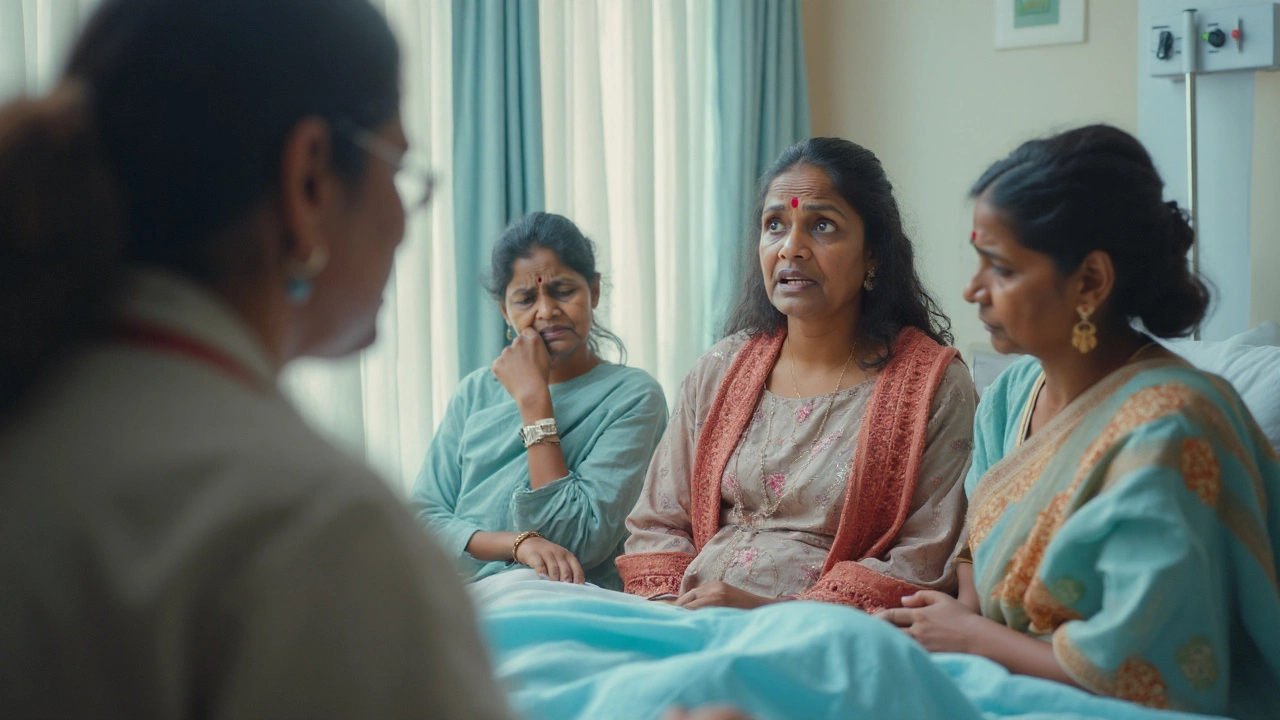
Shocking but true — nearly 4,000 surgical mistakes, also called 'never events', happen in the United States each year. We trust our lives to highly trained surgeons, but no one is perfect. Some mistakes are so jaw-dropping, they sound like scenes straight out of a dark medical drama. So why do these things happen, and can we actually do anything about them as patients?
Wrong Site, Wrong Patient, Wrong Procedure: The Grand Mistake
It sounds impossible, right? Yet 'wrong-site surgery'—where doctors operate on the wrong body part, or even do the wrong procedure entirely—continues to stun patients, families, and even medical teams. Studies from the Joint Commission, which accredits hospitals in the US, say these mistakes happen about 40 times a week nationwide. That's more than five times every single day.
Some of these slip-ups come from simple human errors. Think of similar last names in a busy hospital ward, or a tired, overworked staff rushing before surgery. Sometimes, a right leg instead of a left gets marked. It can also happen if X-rays are flipped around. Hospitals know about the risks. In fact, they've created 'time-out' procedures—sort of like a huddle before a big play—so the entire team confirms the patient’s name, surgery site, and procedure. Yet, with hundreds of moving parts, things slip through the cracks.
One crazy real-life story comes from a Minnesota hospital, where a patient went in for brain surgery—and the wrong side of his skull was drilled. It made national headlines in 2021, but these things rarely get publicized unless there’s a lawsuit. Most of the time, patients pick up the pieces quietly, dealing with extra surgeries, longer hospital stays, a lot of pain, and sometimes, permanent disability.
How do you protect yourself? Read your consent forms before you sign anything. Before a procedure, don’t be shy—make sure every nurse and doctor says your name and can tell you exactly what’s being done. Many hospitals will literally use a marker and ask the patient to help mark the surgical site. If the team skips this, speak up! Bring a friend or relative to double-check things and ask questions out loud. It sounds awkward, but it’s life-changing. Everyone on that surgical team should hear you say, with zero hesitation, "This is my left knee getting fixed, right?" Multiple studies show that active patient involvement halves the risk of these mistakes.
This problem isn’t limited to the US, either. According to the UK's NHS, about 312 "wrong site" mistakes were reported in 2023 across their hospitals. Canada, India, and Australia all face the same risk, and the numbers are only estimates, since not every case is reported. Technology like barcode wristbands and digital checklists are helping, but so far, there’s no magic bullet. Here’s a look at just how some countries compare in reported yearly figures (these numbers only reflect reported cases, so the real totals are likely much higher):
| Country | Reported Wrong-Site Surgeries (per year) |
|---|---|
| United States | Approx. 2,000 |
| United Kingdom | 312 |
| Canada | 110 |
| Australia | 70 |
So, don’t just rely on the system. Ask questions, double-check your paperwork, and use your voice. Your life may depend on it.
When the Tools Get Left Behind: Retained Surgical Items
Imagine waking up from surgery only to find out later there’s a sponge, gauze, or worse—a needle—still inside your body. It sounds like a horror story, but it happens more often than doctors would like to admit. Medical researchers have a name for this: Retained Surgical Items (or RSIs for short). The sponge is actually the number one thing left behind, but scalpels, towels, and clamps pop up too.
No one knows the exact count, but the American Journal of Surgery estimates as many as 1 in every 5,500 surgeries in the US ends with something forgotten inside the patient. Most of the time, the body doesn’t approve—fevers, pain, swelling, sometimes deadly infections. In about 20% of these cases, the results are fatal. There was one infamous case in 2020, where a man complained for months about severe back pain after a simple gallbladder surgery, only to find out months later that doctors had left behind two surgical sponges, each the size of a vodka shot glass.
Why does this happen? Surgery is hectic—especially emergency situations. Nurses have a checklist for every tool used, but in the heat of complicated, bloody operations, it’s incredibly easy to miss a sponge or mishandle the count. When surgeries run longer than expected, or shift changes disrupt the team, mistakes happen. A Harvard study says that the risk doubles if a new nurse or surgeon takes over mid-procedure.
Hospitals are actually working on this problem. Technological fixes like sponges embedded with tiny RFID chips get picked up by electronic scanners before the wound is closed. Some hospitals are using barcode systems or counting trays that beep if something’s missing. But not every hospital has these tools, especially in lower-resource settings. Remember, not all facilities invest in the tech, so the best thing you can do as a patient? Ask about safety procedures, especially for surgeries that happen on nights, weekends, or when hospital staffing is tight—because those are the riskiest windows.
Be alert for any new pain or fevers after surgery, too. If something feels off, speak up! One study out of Johns Hopkins found that half the cases of retained objects were actually diagnosed because patients insisted their symptoms weren’t normal. Pay attention to your body—if pain is not what you expected, or keeps getting worse, you might just save your own life.
Some hospitals post their 'never event' rates on public websites—do a little snooping before you book a surgery. Choose hospitals that are open about patient safety. Here’s a tip: teaching hospitals and large urban centers tend to have better tracking systems in place, but smaller clinics or private hospitals might have higher risks.

The Hidden Danger: Anesthesia Mistakes
Everyone focuses on the surgeon, but the anesthesia team can literally make or break a procedure. When anesthesia mistakes happen, they’re often deadly—or lead to life-changing injuries. These can be as simple as giving too much or too little of the anesthetic, using the wrong kind, or putting the breathing tube in the wrong place.
Let’s get real: Anesthesia is a balancing act. The idea is to knock out pain without shutting down your body. Even with modern monitoring gadgets, things can go wrong fast. Around 1 in 20,000 people die from anesthesia complications in developed countries. But not all mistakes are fatal—some lead to brain damage, heart problems, or waking up in the middle of surgery (called 'anesthesia awareness').
Mistakes are more common in emergency or after-hours surgeries, when the best teams might not be available. Communication problems often play a part. Say you’re severely allergic to a medicine, but nobody checks your chart. Or, the anesthesiologist is handed the wrong vial in a rush. One case in New York ended in tragedy when a young woman went into cardiac arrest after being given a medication she was allergic to—something that would have been caught with a simple pre-op questions.
For most people, the thought of anesthesia is scary enough. What can you do? First, fill out those pre-surgery questionnaires honestly and completely, even if it feels repetitive. If you have allergies, carry a list and repeat yourself as many times as it takes. If something in your medical chart changes—like a new diagnosis or recent illness—tell them again, even if you told the nurse last week.
There’s also a big gap between hospitals with experienced anesthesia providers and small clinics without one. Ask who will provide your anesthesia and what training they have. Board-certified anesthesiologists have more training than nurse anesthetists, though both can be highly skilled. If you’re in a setting where there’s no dedicated anesthesia professional, consider rescheduling or requesting one—especially for anything but the simplest procedures.
According to a 2024 World Health Organization report, about 5% of all hospital medical injuries are related to anesthesia—that’s a huge chunk. Here’s a quick look at the main types of anesthesia mistakes and how often they occur around the world:
| Type of Anesthesia Error | Global Occurrence Rate |
|---|---|
| Wrong dose given | 1 in 10,000 |
| Equipment failure | 1 in 20,000 |
| Airway mismanagement | 1 in 30,000 |
The most important thing? Communication. Don’t let anyone silence your concerns. Surgeons and anesthesia providers should explain the plan, tell you the medicines they’ll use, and check any medical alerts. Ask what the backup plan is if things go wrong—experts say this step saves more lives than any fancy machine.
How to Protect Yourself: Smart Steps for Patients
Now you know the big three surgical mistakes—wrong-site surgeries, retained surgical items, and anesthesia blunders. The common theme is that all of them are preventable, but only if everyone stays alert. The truth is, hospitals and surgeons are working on it. But patients who take an active role in their care are far less likely to end up a statistic.
Here’s what you can do:
- Bring a family member or friend as your 'wingman' on surgery day. They can ask questions and double-check everything when you might be nervous or sleepy.
- Speak up about any allergies, previous surgeries, or weird reactions to meds—never assume anyone knows just by reading your chart.
- If someone forgets to do a 'time-out' before your operation, ask for it. This single step is proven to stop a ton of mistakes.
- Ask what the hospital does to keep track of every tool and sponge — and whether your surgery will use the newest scanning tech.
- After surgery, listen to your body. If something hurts, swells, or feels wrong, call your doctor, even if you’re afraid of seeming pushy or paranoid.
- Check the hospital’s record on patient safety if you can find it. Websites like Leapfrog Group in the US or public health data in the UK reveal hospital error rates.
- Don’t rush decisions. Emergency surgeries are chaotic, but if you have any chance to wait and prepare, use it. Patients who plan their surgeries with their doctors and ask questions are much less likely to face big complications.
Here’s a sobering fact: According to the British Medical Journal, medical errors of all types—including surgery—rank as the third leading cause of death in the US, right behind heart disease and cancer. That’s not meant to scare you senseless, but to show how much power you actually hold as a patient. Doctors aren’t superheroes, and the best ones will thank you for catching the little things that keep everyone safe.
No system is flawless. But by getting involved, trusting your instincts, and calmly double-checking the basics, you do more than just ease your worry—you make surgery safer for everyone who comes after you too. So the next time you or someone you love faces the prospect of surgery, remember: your questions and attention to detail might just save the day.

Write a comment